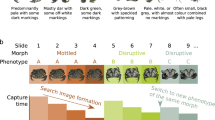Play all audios:

ABSTRACT Populations of coloured baits were presented to wild birds. When the two bait colours were randomly intermingled, the birds ate an excess of the commoner form. However, rarer prey
were preferred if they were aggregated together. The fitness of alleles under apostatic natural selection may thus be related to spatial pattern as well as to frequency. SIMILAR CONTENT
BEING VIEWED BY OTHERS VARIABLE CRAB CAMOUFLAGE PATTERNS DEFEAT SEARCH IMAGE FORMATION Article Open access 05 March 2021 FREQUENCY-DEPENDENT BATESIAN MIMICRY MAINTAINS COLOUR POLYMORPHISM IN
A SEA SNAKE POPULATION Article Open access 18 March 2022 PREY SIZE MEDIATES INTERFERENCE COMPETITION AND PREDATION DYNAMICS IN A LARGE CARNIVORE COMMUNITY Article Open access 28 March 2025
ARTICLE PDF REFERENCES * Allen, J A. 1988. Frequency-dependent selection by predators. _Phil Trans Roy Soc Lond Ser B_, 319, 485–503. Article CAS Google Scholar * Allen, J A, and
Anderson, K P. 1984. Selection by passerine birds is anti-apostatic at high prey densities. _Biol J Linn Soc Lond_, 23, 237–246. Article Google Scholar * Allen, J A, and Clarke, B C. 1968.
Evidence for apostatic selection by wild passerines. _Nature_, 220, 501–502. Article CAS Google Scholar * Bantock, C R, and Harvey, P H. 1974. Colour polymorphism and selective predation
experiments. _J Biol Educ_, 8, 323–329. Article Google Scholar * Clarke, B C. 1962. Balanced polymorphism and the diversity of sympatric species. _Syst Ass Publ_, 4, 47–70. Google Scholar
* Croze, H. 1970. Searching images in carrion crows. Z. _Tierpsychol, Suppl_, 5, 1–85. Google Scholar * Curio, E. 1976. _The Ethology of Predation_. Springer-Verlag, Berlin. Book Google
Scholar * De Ruiter, L. 1952. Some experiments on the camouflage of stick caterpillars. _Behaviour_, 4, 222–232. Article Google Scholar * Edmunds, M. 1974. _Defence in Animals_. Longman,
Harlow. Google Scholar * Gittleman, J H, and Harvey, P H. 1980. Why are distasteful prey not cryptic? _Nature_, 286, 149–150. Article Google Scholar * Greenwood, J J D. 1984. The
functional basis of frequency-dependent food selection. _Biol J Linn Soc Lond_, 23, 177–199. Article Google Scholar * Guilford, T, and Dawkins, M S. 1987. Search images not proven: a
reappraisal of recent evidence. _Anim Behav_, 35, 1838–1845. Article Google Scholar * Horsley, D T, Lynch, B M, Greenwood, J J D, Hard-Man, B, and Mosely, S. 1979. Frequency-dependent
selection by birds when the density of prey is high. _J Anim Ecol_, 48, 483–490. Article Google Scholar * Kareiva, P. 1986. Patchiness, dispersal and species interactions: consequences for
communities of herbivorous insects. In Diamond, J. M. and Case, T. J. (ed.) _Community Ecology_, Harper and Row, New York, pp. 192–206. Google Scholar * Manly, B F J, Miller, P, and Cook,
L M. 1972. Analysis of a selective predation experiment. _Amer Nat_, 106, 719–736. Article Google Scholar * Murdoch, W W, and Oaten, A. 1975. Predation and population stability. _Adv Ecol
Res_, 9, 1–131. Article Google Scholar * Pyke, G H. 1984. Optimal foraging theory: a critical review. _Ann Rev Ecol Syst_, 15, 523–575. Article Google Scholar * Real, L. 1983.
_Pollination Biology_. Academic Press, New York. Google Scholar * Royama, T. 1970. Factors governing the hunting behaviour and selection of food by the Great Tit (_Parus major_ L.). _J Anim
Ecol_, 39, 619–668. Article Google Scholar * Schmitt, R J. 1985. Competitive interactions of two mobile prey species in a patchy environment. _Ecology_, 66, 950–958. Article Google
Scholar * Sih, A, Crowley, P, McPeek, M, Petranka, J, and Stroh Meier, K. 1985. Predation, competition and prey communities: a review of field experiments. _Ann Rev Ecol Syst_, 16, 269–311.
Article Google Scholar * Stephens, D W, and Krebs, J R. 1986. _Foraging Theory_. Princeton University Press, Princeton, New Jersey. Google Scholar * Tinbergen, L. 1960. The natural
control of insects in pine-woods. I. Factors influencing the intensity of predation by song birds. _Arch Neerl ZooL_, 13, 265–336. Article Google Scholar * Tinbergen, N, Impekoven, M, and
Franck, D. 1967. An experiment on spacing-out as a defence against predation. _Behaviour_, 28, 307–321. Article Google Scholar Download references AUTHOR INFORMATION AUTHORS AND
AFFILIATIONS * Department of Genetics and Biometry, University College London, Wolfson House, 4 Stephenson Way, London, NW1 2HE, UK J S Gianino & J S Jones Authors * J S Gianino View
author publications You can also search for this author inPubMed Google Scholar * J S Jones View author publications You can also search for this author inPubMed Google Scholar RIGHTS AND
PERMISSIONS Reprints and permissions ABOUT THIS ARTICLE CITE THIS ARTICLE Gianino, J., Jones, J. The effects of dispersion on frequency-dependent predation of polymorphic prey. _Heredity_
62, 265–268 (1989). https://doi.org/10.1038/hdy.1989.37 Download citation * Received: 03 September 1988 * Issue Date: 01 April 1989 * DOI: https://doi.org/10.1038/hdy.1989.37 SHARE THIS
ARTICLE Anyone you share the following link with will be able to read this content: Get shareable link Sorry, a shareable link is not currently available for this article. Copy to clipboard
Provided by the Springer Nature SharedIt content-sharing initiative
